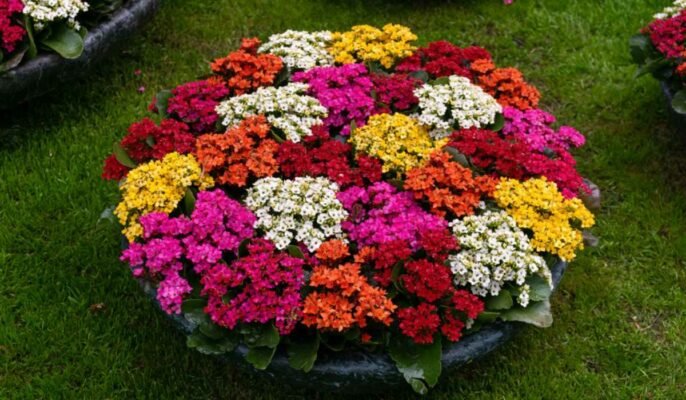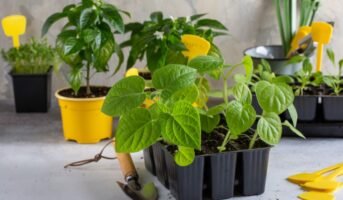Want to add more colour to your home while increasing its green cover? The Flaming Katy, with its abundant and colourful flowers, could be the way to go. This perennial succulent plant is an apt choice for the Indian climate as it requires warm weather to grow.
See also: Verbena hybrida: Bring garden verbena’s radiance to your home
Flaming Katy: Facts
| Common name: Flaming Katy, Christmas Kalanchoe, Florist Kalanchoe, Madagascar Widow’s Thrill
Botanical name: Kalanchoe Blossfeldiana Family: Crassulaceae Type: Perennial Native: Madagascar Sun: Full/partial Soil: Well-drained acidic sandy soil Water: Moderate Toxicity: Toxic for cats and dogs |
Flaming Katy: Description
The plant’s glossy, green, fleshy leaves are opposite, obovate and sessile. About 5 to 10 cm long, the leaves are slightly smooth-edged. Its small, four-petalled flower, found in many colours, is grouped and borne on long stems. Each head carries 20-50 flowers.
Equally popular as a potted indoor plant and a garden ornamental, the Flaming Katy is a succulent shrub that is native to Madagascar. While the average growth is restricted to 30-45 cm, in favourable circumstances, the plant can grow up to 1.5 feet wide and tall.
A plant with an extremely high commercial value, the Flaming Katy is the most-grown flowering potted plant in Europe.
Known about: Pericallis Hybrida
Flowering season
Typically, the plant starts flowering in December and continues to flower for 6-8 weeks. In some countries, the plant is known to flower all around the year.
How to grow?
The plant can be propagated from seeds as well as cuttings. To plant from a cutting, mix equal parts of potting mix with cacti mix for best results. Else, opt for a clay pot. Keep the pot in bright light but don’t water it. Within a month, the stem would form a root. Growing from seeds would take double the time. Yet, if you go that way, sow the seeds on the surface of the potting mix in early spring. Leave the seeds uncovered since they require light to germinate. Placing the container in a plastic bag would help them germinate. It would take nearly two months for the seeds to transform into seedlings. After this, transfer them into individual pots.
Maintenance
- Your plant is easy to maintain. However, it is a slow-growing plantso be patient.
- Your plant needs plenty of sun and limited water. Keep it in a room with abundant sunlight. Water only when the soil dries up to two inches.
- Only during summer and spring, feed your indoor plants with well-balanced fertiliser once a month.
- Prune occasionally to maintain its shape and form.
Infestation
Mildew, mealy bugs, mites and scale insects can infest the plant, impacting its growth. Watch out for these natural enemies of the plant.
Medicinal value
Studies have proven the plant to carry anti-viral, anti-septic, anti-microbial, anti-plasmodial, anti-oxidant, air-purifying and disinfectant properties. Various parts of the plant are used in treating oral cavity diseases, ear, nose and throat diseases, pressure ulcers, sunburns and freeze burns, skin diseases, warts, ischemic ulcers and varicosity.
Also read about the medicinal benefits of the Dandelion
FAQs
Is the Flaming Katy flower/plant toxic?
Yes, the Flaming Katy flower/plant is toxic for animals.
What are the risks of growing Flaming Katy flowers/plants?
It is an invasive species. It has turned out to be so in countries like Dominican Republic, Chile and the Galapagos Islands. In these countries, it has escaped from cultivation and displaced native vegetation.
An alumna of the Indian Institute of Mass Communication, Dhenkanal, Sunita Mishra brings over 16 years of expertise to the fields of legal matters, financial insights, and property market trends. Recognised for her ability to elucidate complex topics, her articles serve as a go-to resource for home buyers navigating intricate subjects. Through her extensive career, she has been associated with esteemed organisations like the Financial Express, Hindustan Times, Network18, All India Radio, and Business Standard.
In addition to her professional accomplishments, Sunita holds an MA degree in Sanskrit, with a specialisation in Indian Philosophy, from Delhi University. Outside of her work schedule, she likes to unwind by practising Yoga, and pursues her passion for travel.
sunita.mishra@proptiger.com

